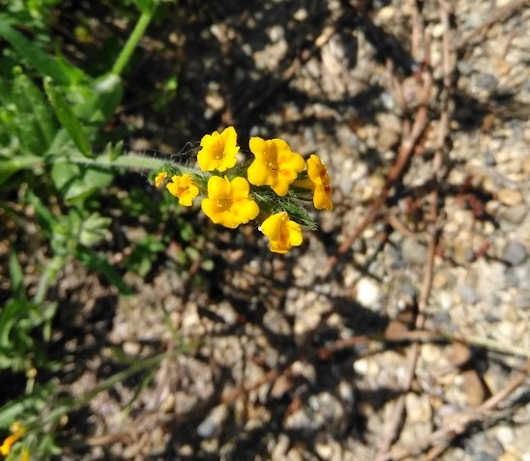By Rebecca Ozeran
As of February 20, fiddleneck (Amsinckia spp.) was flowering in Fresno County. Zero rain fell in the city of Fresno during the month of February. By February 27, a date when the temperature reached 79°F in Fresno, the U.S. Drought Monitor had declared most of California's Central Valley to be in Moderate Drought conditions (D1). This status persists despite cooler temperatures and rain in the middle of March (Fig. 1).
Figure 1. March 31, 2020 Drought Monitor showing moderate drought (D1) in the southern San Joaquin Valley, and the western portion of the entire Central Valley through the north coast. In California, only the southern desert region has seen normal or wetter-than-normal water status to date. Image retrieved from https://droughtmonitor.unl.edu/ on April 2, 2020.
To date, this year has been unusually dry, with Fresno's February tying for the driest on record with two other years (Table 1). But what does this mean for weed populations?
Table 1. Precipitation data for the city of Fresno, collected by NOAA's California Nevada River Forecast Center at the Fresno Airport. Note that even after a few rainy days in March, we are still at less than 60% of average precipitation to date (“
Pct Avg to Date”) for the area. By the end of March in an average year ("
WY to Date") we should have totaled almost 10 inches of rain in Fresno. Data retrieved from
https://www.cnrfc.noaa.gov/monthly_precip.php on April 3, 2020.
ID | Location | OCT | NOV | DEC | JAN | FEB | MAR | WY to Date | Pct Avg to Date | Pct Tot WY |
FAT | FRESNO AIR TERMINAL | 0.00 | 0.72 | 2.16 | 0.66 | 0.00 | 2.10 | 5.64 | 58 | 49 |
Locally, a lot of plants are going through their life cycles on a shortened schedule. Wildflowers and less desirable broad-leaved plants like fiddleneck have reached full bloom in many places, while many desirable grasses haven't quite senesced.
In a good water year, the hillsides here can stay green until late April or even mid-May. But this spring, our desirable and undesirable species are maturing quickly, at relatively low biomass, and almost all at the same time.
Figure 2. When visiting a forage monitoring site near North Fork (Madera County) this February, I saw very little grass growth. By mid-February I would typically expect a few inches of grass. Instead, fallen leaves and residual grass stems from last year lie flat atop very short forbs like filaree (Erodium spp.), which seem to be doing better than grasses in this drought. Later in April I will visit my monitoring sites to measure total forage production.
For ranchers, the low forage production this year - still to be measured locally, but the way things look isn't promising - means there will be less feed on the landscape to keep grazing animals fed through all of summer and fall. This means making difficult decisions about whether to purchase hay, whether to sell more animals than usual, and/or whether to sell their market animals earlier or later.
Moreover, this means that they have almost no treatment window to target annual weeds on their landscapes. In a good year, several species like medusahead, fiddleneck and other undesired annuals typically mature later than the desirable forage grasses. The difference in timing of seed production means that land managers can schedule activities like area herbicide sprays or mechanical treatments when the desired forage species have already produced their seeds, but the undesired species haven't yet produced any. This year, there isn't as much of a separation in timing, which means that convenient treatment window has shrunk – and it may have already passed for some areas.
What can be done?
Some weed species still may not have flowered or produced seeds yet, in which case you might still be able to treat them. Your options depend on the local conditions of your rangelands and the weeds on site. If you are able to actively monitor your property, you will have the best chance of finding a good treatment window. There may also be treatment options which are still effective on an individual plant basis, like hand-pulling or using a backpack sprayer to target small infestations. Contact your local farm advisor to discuss what might work for your particular weed scenario.
Even if this year's management plan is a bust, you can use the time you would have been treating weeds to refine your plan and create contingencies. In particular, you might want to create a drought-year weed management plan. What kinds of alternative treatments, or different timing, might you be able to use if you noticed a similar weather pattern to this year? What species can you use as an indicator that your treatment window is coming up (e.g. Fig. 3)?

Figure 3. Though it is a native plant with charming yellow flowers, fiddleneck is not a forage species, and thus is treated as a weed on many rangelands. It may be an indicator that the ideal time to target certain undesired broad-leaved weeds has already passed. However, some species flower later than fiddleneck and still may be manageable this year. Weather patterns impact species differently, and the site itself changes how weather influences plants - the best first step is to observe on-site conditions before making management decisions.
Source : ucanr.edu